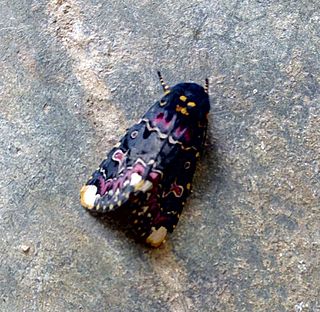
Arsacia is a monotypic moth genus of the family Noctuidae. Its only species is Arsacia rectalis. Both the genus and species were described by Francis Walker, the genus in 1866 and the species in 1863. It is found from the Indo-Australian tropics of India, Sri Lanka to Queensland and the Solomon Islands.
Dactyloplusia is a monotypic moth genus of the family Noctuidae erected by Chou Io and Lu Chinsheng in 1979. Its single species, Dactyloplusia impulsa, was first described by Francis Walker in 1865. It is found in Sri Lanka, India, southern China, Sundaland, Sulawesi, New Guinea, Fiji and Australia.

Dictyestra is a monotypic moth genus of the family Noctuidae erected by Shigero Sugi in 1982. It contains only one species, Dictyestra dissectus, the angle network armyworm, first described by Francis Walker in 1865. It is found from India to Indochina, Sri Lanka, China, Japan, Sundaland and the Philippines and from Sulawesi to the Moluccas and New Guinea.

Dordura is a monotypic moth genus of the family Noctuidae erected by Frederic Moore in 1882. Its only species, Dordura aliena, was first described by Francis Walker in 1865. It is found in the Indian subregion, Sri Lanka, Myanmar, Thailand, Peninsular Malaysia, Sumatra, Borneo and New Guinea.
Elusa is a genus of moths of the family Noctuidae erected by Francis Walker in 1859.
Eurois is a genus of moths of the family Noctuidae first described by Jacob Hübner in 1821.
Hyperlopha is a genus of moths of the family Noctuidae. The species was first described by George Hampson in 1895.
Mecodina is a genus of moths of the family Noctuidae first described by Achille Guenée in 1852.
Mosopia is a genus of moths of the Noctuidae family. It is found in south-east Asia, including Thailand, Borneo and Malaysia. The genus was first described by Francis Walker in 1866 from a specimen in the British Museum. The specimen Walker describes was from Penang in Malaysia.
Plusia is a genus of moths of the family Noctuidae. The genus was erected by Ferdinand Ochsenheimer in 1816.

Polytela is a genus of moths of the family Noctuidae erected by Achille Guenée in 1852. Species are distributed across the Old World.
Rabila is a genus of moths of the family Noctuidae erected by Francis Walker in 1865. The genus once thought to endemic to Sri Lanka, but species now found from South India and few African countries.
Saroba is a genus of moths of the family Noctuidae.

Sphetta is a genus of moths of the family Noctuidae first described by Francis Walker in 1865.

Spodoptera is a genus of moths of the family Noctuidae first described by Achille Guenée in 1852. Many are known as pest insects. The larvae are sometimes called armyworms. The roughly 30 species are distributed across six continents.
Tephriopis is a genus of moths of the family Noctuidae.
Zonoplusia ochreata is a moth of the family Noctuidae first described by Francis Walker in 1865. It is found in the Oriental tropics of India, Sri Lanka, north to Japan, east to Hong Kong, Sundaland and the Philippines. The species is also known from the Australian state of Queensland.

Condica dolorosa is a moth of the family Noctuidae. It is found in the Indo-Australian tropics, including Borneo, Hawaii, Hong Kong, India, Sri Lanka, Taiwan and Queensland in Australia.
Brana is a monotypic moth genus of the family Noctuidae. Its only species, Brana calopasa, is found in Sri Lanka and Australia. Both the genus and species were described by Francis Walker, the genus in 1858 and the species in 1859. It It is a serious pest on Berrya cordifolia.
Feliniopsis opposita is a moth of the family Noctuidae first described by Francis Walker in 1865. It is found in Kenya, Somalia, Sri Lanka and India.








